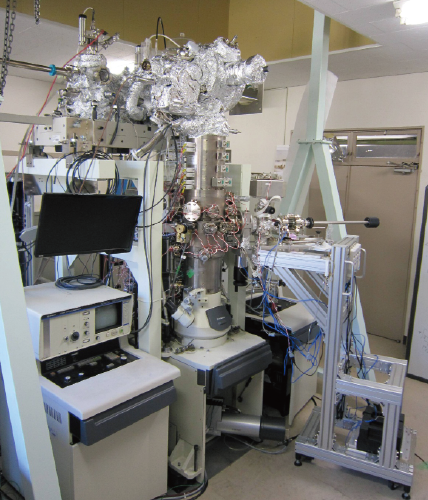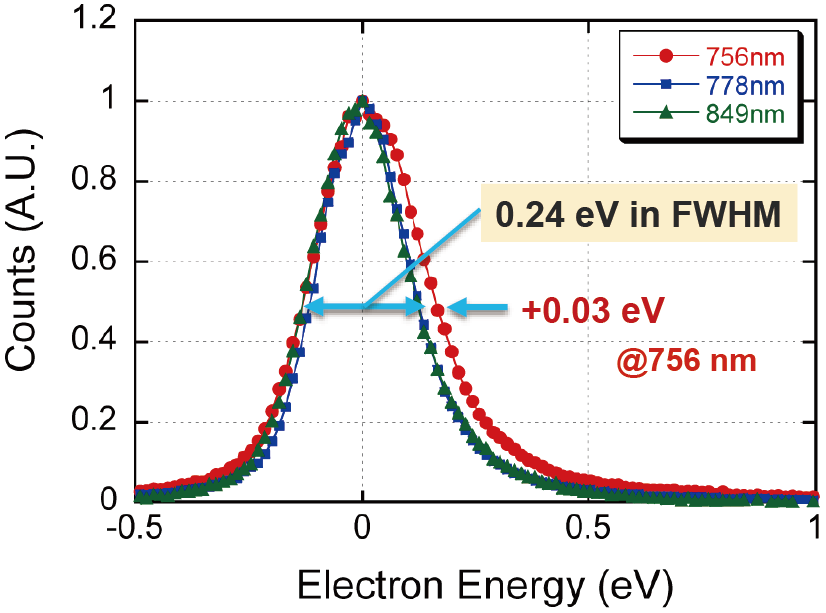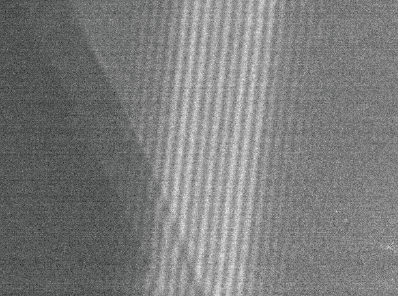IT-5-P-1792 Spatial and Temporal Coherences in Spin-Polarized Transmission Electron Microscopy
Great advances have recently been made in magnetic recording technology and spintronic devices, which are promising for high-density storage devices. Such devices are expected to lead to the development of systems that can analyze magnetic and spin states with a nanometer-order spatial resolution.
We have commenced a development of a spin-polarized transmission electron microscope (SPTEM), which consists of a polarized electron source (PES) and a conventional TEM [1-3]. Figure 1 shows a photograph of the SP-TEM. Spin-polarized electrons can be generated using an optical orientation of III–V semiconductors and vacuum extraction that uses a negative electron affinity (NEA) surface. Several beam parameters of the PES are vastly superior to those of conventional thermal electron beams. In addition, it has the ability to generate a sub-picosecond multibunch beam[4]. A high ESP of 92% and a high QE of 0.5% have been realized using a GaAs–GaAsP strained superlattice photocathode[5].
We have already demonstrated that the SPTEM can provide both TEM images and the diffraction patterns [1]. The TEM images can be obtained in a spatial resolution of 1 nm in a 30-kV acceleration voltage. The apparatus has a below 240-meV energy width of electron beam in the TEM without any monochrometors (Fig. 2). The energy width indicates the temporal coherence is about 2.7 fs (longitudinal coherence of 2.7×10-7 m) at 30-keV beam energy. A brightness is directly measured by taking a spot size and a convergent angle on an image plane. The measured brightness is about 4×107 A/cm2sr in a 30-keV beam energy with a polarization of 82 % and the drive-laser power of 800 kW/cm2 on the photocathode [6]. The brightness for a 200-kV beam energy is 3×108 A/cm2sr which is converted by using a Lorentz factor. The order of the brightness is enough to do an interference experiment. We also demonstrated interference fringes of spin-polarized electron beam by using a newly installed biprism as shown in figure 3. These results indicate the SP-TEM can provide enough coherence in both lateral direction and longitudinal direction even if the semiconductor photocathode is used for an electron emitter.
[1] M. Kuwahara et al., Appl. Phys. Lett. 101 (2012) 03310
[2] M. Kuwahara et al., AMTC Letters 3 (2012) 180.
[3] M. Kuwahara et al., J. Phys.:Conf. Ser. 298 (2011) 012016.
[4] Y. Honda, et al., Jpn. J. Appl. Phys. 52, 086401-086407(2013).
[5] X.G. Jin et al., Appl. Phys. Express 1 (2008) 045002.
[6] M. Kuwahara et al., to be submitted (2014).
The authors thank Drs. H. Shinada, M. Koguchi and M. Tomita of Hitachi Central Research Laboratory for fruitful discussions and encouragement. This research was supported by MEXT KAKENHI Grant Number 51996964, 24651123, 25706031 and Kurata Research Grants from the Kurata Foundation.


